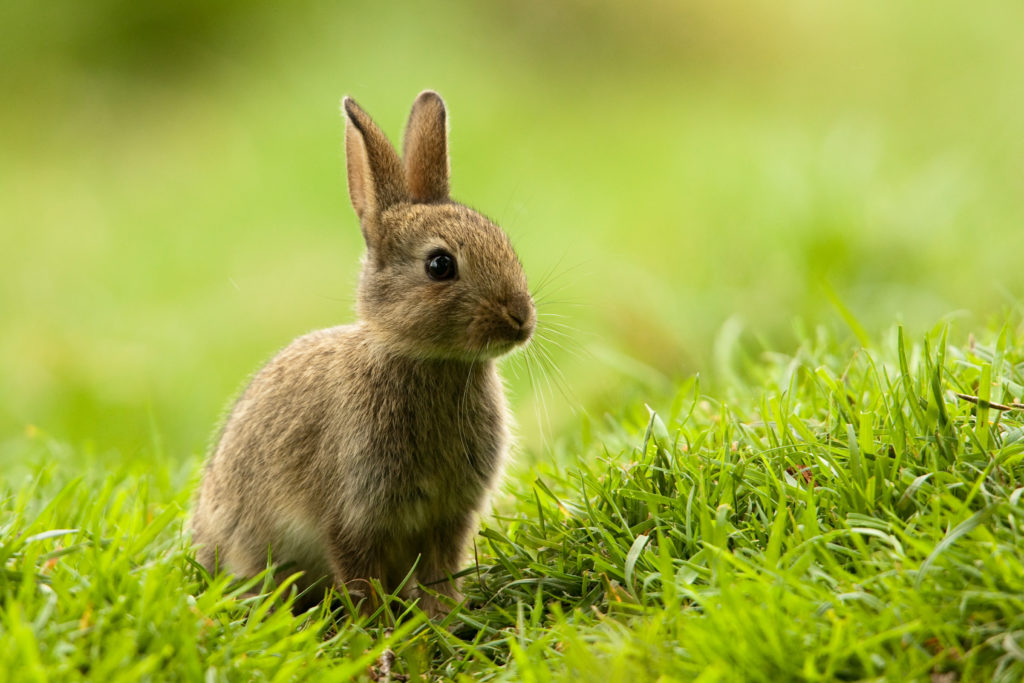
Bunnies, Bunnies Everywhere!
During bunny season PLEASE when doing lawn work,
check out the area before you mow or weed whack!
Wild rabbits will build their nests in the most ridiculous places. We find them in the middle of a yard, the middle of a ball field and even under swing sets. If you happen upon a nest, LEAVE IT ALONE!!!
YOU DO NOT WANT HUMAN SCENT ON THE NEST. Will it make Mom stay away? Not necessarily. What will happen is that predators will be more likely to find the nest by your scent and thus the babies.
Bunnies open their eyes at 10 days and at 12 will begin to come out of the nest to graze. Often, because they are so tiny, when seen by people they are assumed to be orphaned or in trouble. NOT SO! They are doing just what they are supposed to be doing. If the bunnies’ eyes are closed, they will be gone within three weeks; if eyes are open you are looking at another week or a little longer.
REMEMBER: Just because you don’t see the mother doesn’t mean she is not around. She is usually in the area and will be back for her babies late in the evening or after dark.
Once you find a nest, here are a few things that you can do to help protect the nests:
- DO NOT TAKE BUNNIES OUT OF THEIR NEST. If you don’t see the mother, it’s because she only comes to the nest late evening or nighttime. If you believe mother is not coming to the nest, take two pieces of light string and make an X over the top of the nest. You’ll want to do this late evening and check the string right before daylight. If the string is moved, the mother is there: LEAVE THEM ALONE. If it hasn’t moved, CALL A PROFESSIONAL WILDLIFE REHABILITATOR before you pick them up.
- Place a stake close to where the nest is so that when you mow you can skip that one small section.
- Place a clothes basket upside-down over the nest during the day and take it off in the evening and during the night so the mother can get to them.
- Build or wrap a small fence surround the nest – you’ll want to place the bottom of the fence just off of the ground high enough that the mother rabbit can get under it.
- If you have a brush pile that you intend to burn, please check under it before doing so. Every year I receive at least one litter that suffers burns because their nest was under a brush pile that was set on fire.
- If you run over a nest with a mower, the babies with eyes closed will squat and freeze in the nest. Those with eyes open will tend to jump up and take off running. Sometimes they are successful; sometimes they are killed or injured. If injured, call a rehabilitator.
- If they do make it out, DO NOT CHASE THEM! Take a rake and rake as much of the nest material as possible over the nest and leave it alone. They know where their nest is and when you leave, they will go back.
- If your dog or cat discovers a nest, they will not leave it alone. Please do what you can to keep them away from the nest by tying them up, or keeping them in an enclosed area away from the nest. Bunnies grow up fast and you will not have to control your pet for very long.
DOGS AND BUNNIES
Dogs along with cats find bunny nests; however, dogs do not torture them like cats do but they will dig vigorously at the nest and injure the babies.
If your dog brings you a baby bunny, please see if you can follow your dog to find out where the nest is. Often, the dog will go back to get more babies. If the dog takes you to the nest and you are sure the bunny that the dog brought to you is unhurt, pull up some grass and rub the bunny down to get the scent of both you and the dog off of it and place it back in the nest.
You will also need to monitor your dog or tie it up because it will not leave those bunnies alone. I am often told it is impossible to tie the dog up, but PLEASE TRY; it won’t be long before they are gone.
If the bunnies’ eyes are closed, they will be gone within three weeks; if eyes are open you are looking at another week or a little longer.
CATS AND BUNNIES
Every year, one-third of the bunnies and birds that I receive are the direct result of the domestic cat—one that is well-fed by their owners but allowed to roam outside. The difference between a pet cat (or a feral cat that is being fed by someone) and a wild one is that when they get a hold of a wild animal, they DO NOT kill and eat for survival. Instead they just kill, or more often than not, they capture, TORTURE, bash it around (causing internal injures) and let the animal lay and die a slow death. They kill for the entertainment.
I’ve made a plea before about cats and wildlife (see my post “NOT FUN”) and ask you to please keep your cats inside or in a protected enclosure.
Doing just these little things will help save and protect these bunnies from being injured or killed. Thank you! ~ Fran Kitchen
WILDLIFE PROGRAMS AND DISPLAYS
If you would like to see many of these animals up close, please consider booking one of our Wildlife Programs or Displays that are reasonably priced and perfect for Organizations | Schools | Churches | Campgrounds | Nursing Homes | Fundraisers | Displays at Events. All money generated from the programs & displays goes right back into the care of the wildlife.
For more information about our programs, visit our programs page.
Copyright 2017 Fran Kitchen
Operation Orphan Wildlife Rehabilitation, Inc. is a 501(c)3 Non-Profit Organization and does not receive federal funding. We are supported entirely through private donations, memberships, and proceeds from our education programs. Click here to donate.
